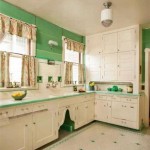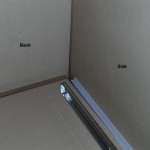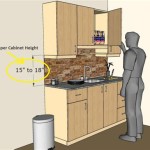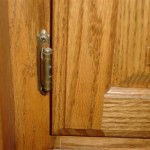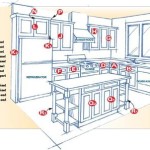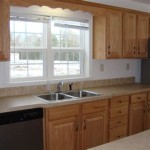What Finish Should Kitchen Cabinets Be Painted?
Selecting the appropriate finish for painted kitchen cabinets is a critical decision impacting both the aesthetic appeal and the long-term durability of the space. The finish chosen significantly affects the cabinets’ resistance to daily wear and tear, cleaning ease, and overall visual impact. Numerous options are available, each with its advantages and disadvantages, requiring careful consideration of factors such as budget, desired aesthetic, and lifestyle.
Painted kitchen cabinets offer a versatility unmatched by stained wood, allowing homeowners to customize their kitchens with a wide spectrum of colors and styles. However, the quality of the paint job and the type of finish applied directly influence how well the cabinets withstand the rigors of a busy kitchen environment. Considerations should extend beyond immediate visual appeal, encompassing the ease of maintaining a clean and attractive surface over time.
Understanding Paint Sheens and Their Characteristics
Paint sheen refers to the amount of light a painted surface reflects. Different sheens offer different levels of reflectivity, durability, and ease of cleaning. Selecting the correct sheen is crucial for achieving the desired aesthetic and ensuring the cabinets can withstand the demands of a kitchen environment. The primary sheens to consider for kitchen cabinets include matte, eggshell, satin, semi-gloss, and gloss. Each sheen possesses distinct properties that influence its suitability for this application.
Matte Finish: Matte finishes offer the lowest level of sheen, providing a soft, non-reflective appearance. This finish effectively conceals imperfections on the cabinet surface, making it a popular choice for older cabinets with minor flaws. However, matte finishes are generally less durable and more difficult to clean than higher-sheen options. They tend to absorb stains and are not as resistant to scrubbing, making them less ideal for high-traffic areas like kitchens. While the elegant, muted look of a matte finish is appealing, its practical limitations often outweigh its aesthetic benefits in the context of kitchen cabinets.
Eggshell Finish: Eggshell finishes offer a slight sheen, resembling the surface of an eggshell. This finish provides a better balance between aesthetics and durability compared to matte finishes. Eggshell is more resistant to stains and easier to clean, but it still may not be ideal for areas prone to frequent spills or heavy use. While offering a subtle reflectivity, it doesn't mask imperfections as effectively as matte. It is often considered a middle-ground option, providing a more sophisticated look than matte while offering slightly improved cleanability.
Satin Finish: Satin finishes are a popular choice for kitchen cabinets due to their balance of durability, cleanability, and visual appeal. This finish offers a moderate sheen, providing a soft, velvety appearance. Satin is more resistant to stains and scratches than matte or eggshell finishes and is easier to clean. It is also less likely to highlight imperfections on the cabinet surface. The slightly higher sheen level allows for better light reflection, brightening the kitchen space. The ease of maintenance and durability make satin a practical and aesthetically pleasing option for most kitchen cabinet applications.
Semi-Gloss Finish: Semi-gloss finishes offer a higher level of sheen, providing a more reflective and durable surface. They are highly resistant to stains, moisture, and scrubbing, making them an excellent choice for high-traffic areas like kitchens and bathrooms. Semi-gloss is easy to clean and maintain, but its reflective surface can highlight imperfections on the cabinet surface. While offering superior durability, the higher sheen level may not be desirable for all aesthetic preferences. It’s often used in contemporary or modern kitchens where a more sleek and polished look is desired.
Gloss Finish: Gloss finishes offer the highest level of sheen, providing a highly reflective and durable surface. This finish is extremely resistant to stains, moisture, and scrubbing, making it ideal for areas that require frequent cleaning. However, gloss finishes are highly reflective and can highlight imperfections on the cabinet surface, requiring meticulous surface preparation. They offer a modern, high-end look but require consistent cleaning to maintain their shine. Gloss finishes are typically reserved for more specialized design schemes and may not be suitable for all kitchen styles.
Factors to Consider When Choosing a Finish
Selecting the appropriate paint finish for kitchen cabinets requires considering several factors beyond personal preference. These factors directly influence the cabinets’ longevity, ease of maintenance, and overall aesthetic integration with the kitchen design. Understanding these aspects is crucial for making an informed decision that aligns with both practical needs and desired style.
Durability and Resistance to Wear and Tear: Kitchen cabinets are subjected to daily use, including spills, splatters, and frequent cleaning. The chosen finish should be durable enough to withstand these rigors without showing signs of wear or damage. Higher sheen levels, such as semi-gloss and gloss, generally offer greater durability and resistance to scratches and stains. Consider the level of activity in the kitchen and the potential for exposure to moisture and grease when assessing the required durability.
Ease of Cleaning and Maintenance: Maintaining clean kitchen cabinets is essential for hygiene and aesthetics. The chosen finish should be easy to clean with common household cleaners without damaging the paint. Higher sheen levels, like semi-gloss and gloss, are typically easier to wipe down and less likely to absorb stains. Matte and eggshell finishes, while aesthetically pleasing, may require more effort to clean and may not be as resistant to staining. The time and effort required for maintenance should be factored into the decision-making process.
Aesthetic Preference and Kitchen Style: The paint finish should complement the overall aesthetic of the kitchen. Matte finishes offer a softer, more traditional look, while gloss finishes provide a modern, high-end appearance. Satin and semi-gloss finishes offer a balance between these two extremes. Consider the existing décor, lighting, and architectural style of the kitchen when selecting a finish. The finish should enhance the overall cohesiveness of the space and reflect the desired style.
Budget Considerations: The cost of paint and labor can vary depending on the chosen finish. Higher-sheen finishes may require more coats of paint and more extensive surface preparation, increasing the overall cost. It is also important to factor in the potential cost of future maintenance and repairs. While a higher-quality finish may have a higher upfront cost, it can potentially save money in the long run by reducing the need for frequent repainting or repairs. Balancing budget constraints with the desired level of durability and aesthetic appeal is critical.
Lighting Conditions: The amount of natural and artificial light in the kitchen can influence how the paint finish appears. Higher-sheen finishes reflect more light, which can brighten a dark kitchen. However, in a kitchen with abundant natural light, a high-gloss finish may appear too reflective. Matte finishes absorb more light, which can make a small kitchen feel even smaller. Consider the lighting conditions when selecting a paint finish to ensure the cabinets look their best.
Proper Application Techniques for a Durable Finish
Even with the selection of a suitable paint finish, proper application techniques are crucial for achieving a durable and aesthetically pleasing result. Poorly applied paint can result in uneven coverage, drips, and premature wear and tear. Following best practices for surface preparation, priming, and painting will ensure the cabinets look their best and withstand the demands of a kitchen environment.
Surface Preparation: Thorough surface preparation is essential for ensuring proper paint adhesion and a smooth finish. This includes cleaning the cabinets to remove grease, dirt, and grime. Sanding the cabinets to create a slightly roughened surface also promotes better paint adhesion. Fill any holes or imperfections with wood filler and sand smooth. Proper surface preparation is the foundation for a long-lasting and attractive paint job.
Priming: Applying a primer coat is crucial for sealing the surface, promoting paint adhesion, and preventing stains from bleeding through. Choose a high-quality primer that is compatible with the chosen paint and cabinet material. Apply the primer in thin, even coats, allowing it to dry completely before applying the topcoat. Priming helps ensure uniform color and a durable, long-lasting finish.
Painting Techniques: Use high-quality brushes and rollers designed for the chosen paint type. Apply thin, even coats of paint, allowing each coat to dry completely before applying the next. Avoid over-brushing or over-rolling, as this can create uneven textures and visible brushstrokes. Consider using a paint sprayer for a smoother, more professional finish. Proper painting techniques are essential for achieving a flawless and durable result.
Curing Time: Allow the paint to cure completely before reassembling the cabinets and putting them back into use. Curing time allows the paint to fully harden and develop its maximum durability. Consult the paint manufacturer's instructions for recommended curing times. Rushing the curing process can result in damage to the paint and premature wear and tear.
Professional Application vs. DIY: While painting kitchen cabinets is a DIY project, achieving a professional-quality finish requires skill, experience, and specialized equipment. If unsure about the ability to achieve the desired result, consider hiring a professional painter. A professional painter has the knowledge, skills, and equipment to ensure a flawless and durable finish. While hiring a professional will incur additional costs, it can be a worthwhile investment in the long-term appearance and durability of the kitchen cabinets.

How To Paint Kitchen Cabinets Like The Pros

Best Paint For Kitchen Cabinets Solved Bob Vila

Best Paint Finish For Kitchen Cabinets 4 Cabinet Compared

How To Paint Kitchen Cabinets A Step By Guide Confessions Of Serial Do It Yourselfer

The Best Paint Finish For Kitchen Cabinets Color Project

How To Paint Kitchen Cabinets Like The Pros

Painting Kitchen Cabinets Best Tips For A Factory Smooth Finish In My Own Style

Should You Use A Paint Finish For Kitchen Cabinets

The Right Way To Paint Your Kitchen Cabinets And Save Factory Finish Guaranteed Emily Henderson

Avoid These Mistakes How To Paint Cabinets That Are Already Painted Grace In My Space
Related Posts


